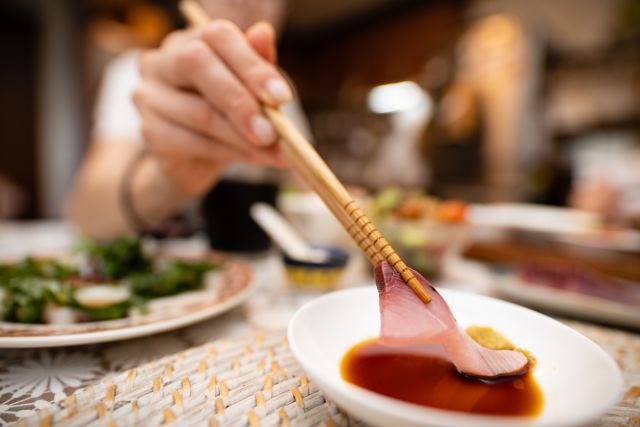Updated on May 16, 2023.
Traditional Japanese sushi can be a great source of lean protein that's high in heart-healthy omega-3 fatty acids, while being relatively low in calories and unhealthy saturated fat. But leave it to Americans to supersize it.
What started out as truly lean cuisine now arrives on platters for one that could easily feed a family of four. Likewise, traditional Japanese sushi kitchens don't use oil or mayonnaise, says Hiroko Shimbo, chef and author of The Sushi Experience. But chances are your favorite sushi bar serves rolls packed with fried shrimp and spicy tuna or salmon laced with mayo.
What's a calorie-counting sushi lover to do? For starters, don't tackle a 20-piece sushi platter yourself. Then read on for tips on how to maximize your enjoyment while keeping a lid on calories and fat.
Meshi-agare (that's Japanese for bon appetit)!
Higher-fat choices to avoid
These common picks in American sushi restaurants tend to be higher in calories and fat. Order them sparingly.
Tempura rolls: Any tempura dish—that means deep-fried—can be high in calories and fat. A typical shrimp tempura roll, for example, can deliver 500 calories and 20 grams of fat. Breading and deep-frying boosts the cholesterol, too.
Spicy tuna and other mayo-based rolls: Before you order, ask if the minced fish is mixed with mayonnaise. If so, that delicate roll may harbor as many as 450 calories and 11 grams of fat.
Philadelphia rolls: Unheard of in Japan, this salmon-and-avocado wonder is schmeared with something a sushi purist wouldn't consider: cream cheese. Calories for a roll start at 300 and rise, depending on how much cheese is used. A clue: Two tablespoons of cream cheese add 10 grams of fat (6 grams of saturated fat).
Dragon rolls (and pretty much anything else made with eel and/or toro): Just 1 ounce of raw eel has 3 grams fat, and toro—sliced from the fatty belly of tuna—packs 7 grams per ounce. Even though the fat is the heart-healthy omega-3 kind, fat is still loaded with calories, and the trade-off here is high. Feel free to indulge in a special treat of toro on occasion, but try not to make these slices the centerpiece of your meal.
Lower-calorie options to enjoy
You can still enjoy the succulent flavor of sushi without adding undue fat or calories. Try these picks.
Assorted sashimi: Sashimi is sliced fish a la carte, and by omitting the rice that would make it sushi, you can save 30 calories per piece. Plus, says Shimbo, eating an assortment of fish—white, red, oily—creates delicious synergies: You get the flavors and benefits of each. For instance, delicate white fish has fewer calories, while richer mackerel and salmon have more omega-3 fatty acids.
Veggie rolls: Cucumber rolls and tangy pickled vegetable rolls are essentially free of fat and provide a pleasantly crunchy contrast to the soft texture of fish sushi—and add only about 150 calories a roll. For a vegetarian entree that packs heart-friendly fat as well as some iron and protein, try a shiitake, avocado, and pickled-ginger roll. That little sheet of seaweed that holds it all together? It gives you calcium, vitamins C and K, and folate.
Edamame (soybeans): Okay, they're not sushi. But they're a staple at sushi bars and one of the healthiest menu choices you can make, brimming with fiber, folate, iron, and protein. Half a cup of steamed edamame has 127 calories and a whopping 11 grams of protein, hence its nickname: "meat from the vegetable garden."
Tako (octopus) or ika (squid): Though relatively high in cholesterol, both are even higher in protein, B vitamins, iron, selenium, and taurine, an amino acid that helps keep your arteries, heart, and eyes healthy. And they boast almost no fat and only 25 calories an ounce.
This may sound like a pared-down approach to sushi, but it's actually sushi the way it ought to be: naturally healthy. So don't hesitate to enjoy a variety of sushi flavors. Eating at least one serving of fish per week can make your RealAge as much as 2.7 years younger.






